Asus ROG Ally: Power in your palms
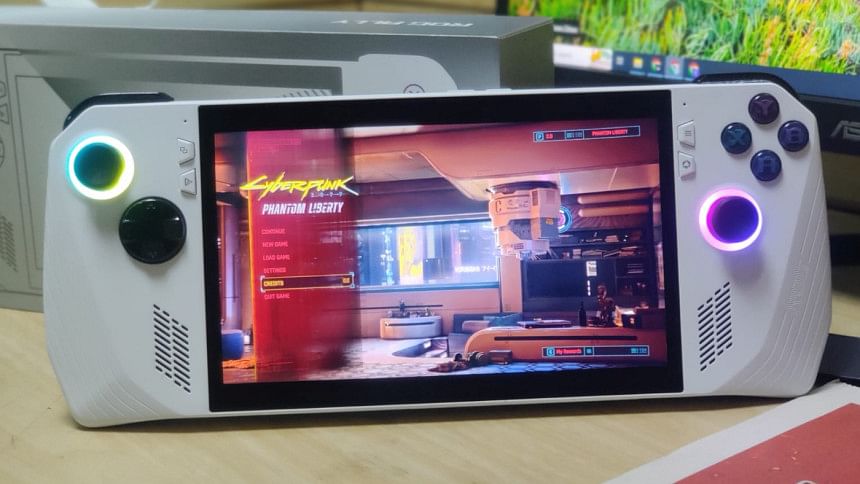
Ever since the original Steam Deck dropped in 2021, there's been a noticeable surge in the demand for handheld computers, all thanks to the rise of the on-the-go, mobile lifestyle. Officially released this year, Asus's ROG Ally jumps into the ring as a strong contender among handheld gaming consoles like the Steam Deck, Lenovo Legion Go, and Aya Neo - promising a feature-packed mobile gaming experience with considerable computational muscle. But the main question remains: how does it hold up? In our hands-on review, we took the brand new Asus ROG Ally for a spin, digging into its build and performance. Does it go the distance, and is that hefty BDT 89,900 price tag justified? Let's find out.
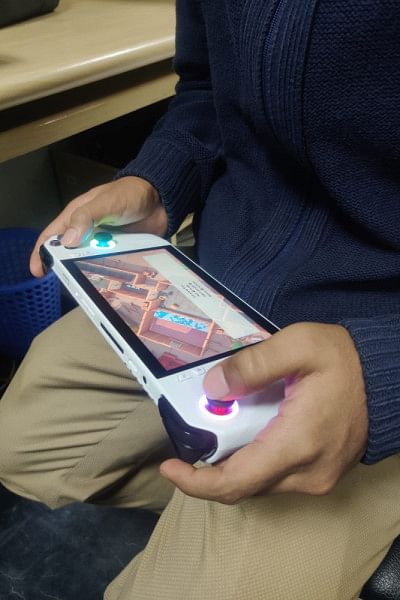
Size and weight
The first thing that hit us upon initial inspection was the deceptive dimension of the device. While still small enough to be comfortably navigated with both hands, the device is larger than expected; measuring in at 11 inches with a display real estate of 7 inches. The size of the display feels proportionate enough to allow users to see details with sufficient clarity. However, over long periods of usage, some users might find the weight of the 608-gram device to be a little cumbersome.
Joystick and buttons
Using a joystick to move a mouse cursor has never been a fun activity, and still isn't. The joystick and the buttons themselves, though, provide an ample amount of grip and sturdiness. The device comes with two different button mapping schemes: one for regular usage, and the other for gaming. Either option is bound to pose a learning curve, especially when you might be required to adjust keyboard settings sliders when booting a new game.
The gameplay itself feels more or less like a regular gamepad experience with no complaints. There are dedicated buttons for volume, which for a device its size provides plenty. There are also two buttons at the back of the device, which enable control switching in-game, though in our limited time with the device, we didn't use these buttons too often.
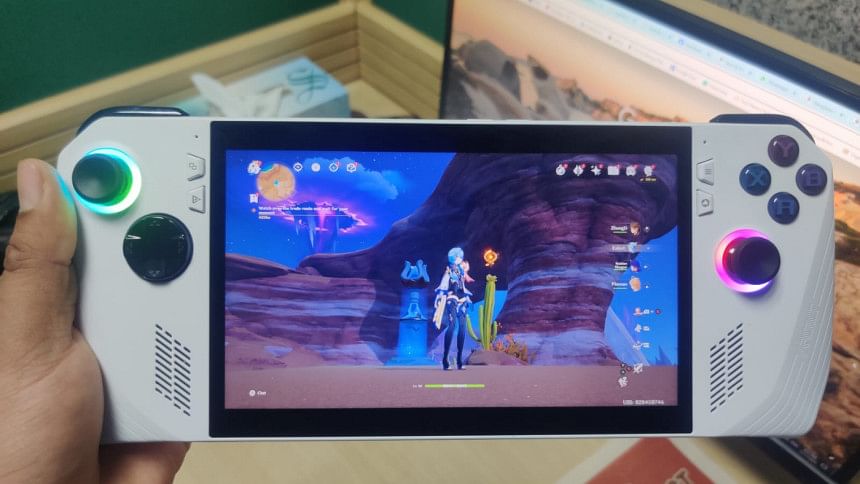
Display screen
The 120 Hz IPS display is a feat for the eyes, and it is embellished by the satisfactory brightness of the Ally. While indoors, the brightness at medium gets the job done most of the time, that is unless you are sitting under direct light, where the device should require the maximum level of brightness to clearly see each little detail.
The viewing angles are a point of concern as the screen poses some glare effects at certain angles. A higher brightness, no doubt, comes at the cost of battery life, which it does drain liberally. The refresh rate is set according to whichever power plan the device is using, and along with a lower brightness can be set to 60 Hz to save that precious battery life. Colours are vibrant enough for gaming and content consumption purposes, but best not to have high hopes for professional-grade calibration work.
Under the hood
Cutting to the chase, the device is surprisingly powerful. Seeing an actual demanding triple-A title run smoothly on a device this small is a pleasant surprise. The device has 3 power modes: Power Saving, Performance, and Turbo. A point to note is that the device will struggle at resolutions like 1080p, however, lower resolutions and texture settings do not deter from the gaming experience given the device's smaller display.
For our testing, we played Cyberpunk 2077. On Turbo mode with the lowest settings in 1080p, the game sticks around the 40 fps ballpark, but cranking the resolution down to 720p provides a 60 fps experience. Performance mode in 720p low can also yield around 40 fps. FSR (FidelityFX Super Resolution) was set to balance in all settings, but a couple more fps could be gained by turning it to Performance mode.
A pleasant gaming experience can be subjective, so tweaking the settings to your preferences is imperative. As for raw benchmark scores, our unit scored 1823 on the 1080p Furmark GPU stress test, 2350 on the Cinebench R15 multi-core test, and 270 on the single-core test. For context, a desktop Ryzen 3700X has a multi-core score of 2116, and a 5900X has a single-core score of 271.
Bottom line? At its best, it is on par with desktop counterparts released a few years ago. The device feels snappy as expected and usual productivity work and multitasking pose no challenge. If power efficiency and battery life weren't a factor, the ROG Ally was sure to blow competition like the Steam Deck and Lenovo Legion Go out of the water.
Battery life
The most significant drawback of the Ally is its battery life. Throughout our benchmarks, light gaming, some mixed tasks, and switching from different power modes, the battery lasted a bit more than 2.5 hours. While in Power Saving mode, the device is shown to have 4 hours of backup time, which quickly changed to a quarter of it in performance mode, and about half an hour in turbo mode.
The display also plays a huge role in draining the battery fast. The only plausible way to use Turbo mode is to plug in the device while using it. The 65W Fast Charging does make some redemption though, being able to fully charge the Ally in as fast as 45 minutes.
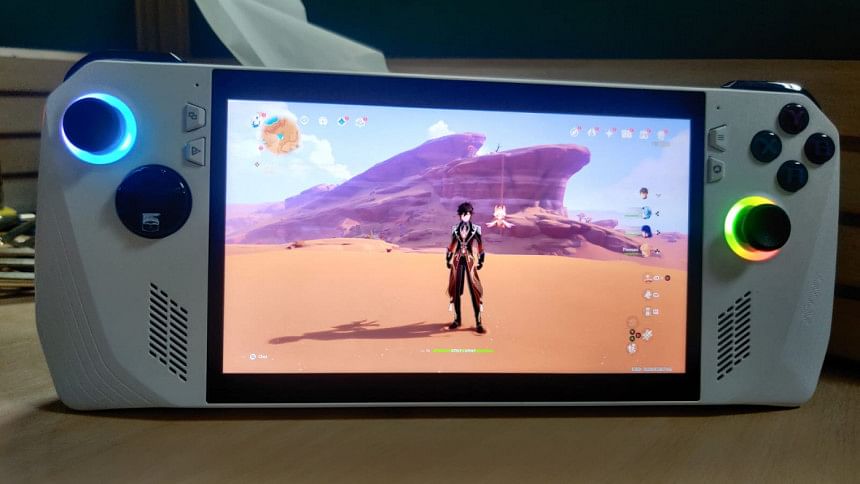
Dawn of the new portable workstation… maybe?
While using joysticks to run a computer might not make sense to everyone at first sight, the Ally could very well turn into your next workstation if tweaked properly. A new trend of replacing desktop or laptop setups is on the rise in tandem with the growing interest in the handheld market. Keep in mind that this device runs on Windows 11, so you can easily run your regular apps and games as you would on your Windows PC.
Additionally, the Ally can easily be hooked up with a monitor and to the power supply using the ROG Gaming Charger dock, and with the use of a hub, can be connected to all the necessary desktop peripherals to provide a complete desktop experience that is extremely portable at the same time. This can be an opportunity for people looking for better portability while still not having to invest all their money for 'just' a gaming device.
Taking the Ally to the office, plugging in the monitor and peripherals to work, and then taking it out to game on the commute back home does not sound so far-fetched now. The handheld device can soon turn into an all-you-need device, thanks to its modularity.
Verdict
So, is this ROG Ally well suited to warrant a hefty BDT 89,900 BDT price tag? To be fair, any handheld or portable computer will be significantly costlier for similar performance to its desktop counterpart. The ROG Ally is no different.
The point of interest to be looked at is what it offers other than performance, a heightened portability and a modular computer that can be used as a full workstation with the right equipment, and great on-the-go performance albeit sporting disappointing battery life which brings the recommendability down a notch.
When compared to major alternatives like Steam Deck and Lenovo Legion Go, the Ally overpowers them in terms of raw performance but fails to keep up with their battery life and power efficiency. But if you're not concerned about battery performance and plan on using the device plugged in most of the time, the Ally is a no-brainer. Similarly, if the idea of a complete desktop overhaul with a handheld replacement for both work and play interests you, then the Ally is the perfect fit for you.

 For all latest news, follow The Daily Star's Google News channel.
For all latest news, follow The Daily Star's Google News channel. 

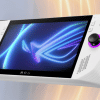
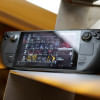


Comments